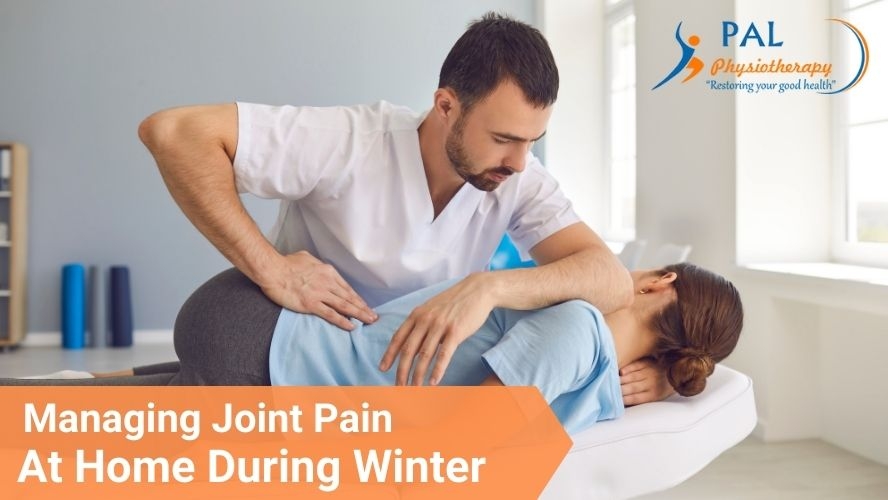Winter often brings more than just cold weather; for many, it also worsens joint pain. The chilly temperatures can lead to stiffness, reduced mobility, and increased discomfort, especially for those with arthritis or other chronic joint conditions. However, with the right strategies, including simple exercises and heat therapy, you can effectively manage joint pain from the comfort of your home.
Dr. Rajesh Pal, a renowned physiotherapist and joint pain specialist from PAL Physiotherapy Clinic, Gurgaon, shares a comprehensive guide to keeping your joints healthy and pain-free this winter.
Why Winter Worsens Joint Pain
Cold weather can tighten muscles and reduce blood flow to joints, making them stiff and painful. Changes in atmospheric pressure during winter can also increase joint swelling, especially for those with arthritis or old injuries. Understanding these triggers is the first step to effective pain management.
Step 1: Stay Active with Simple Home Exercises
Physical activity is essential to prevent joint stiffness, improve blood circulation, and maintain mobility. Here are tailored exercises for key problem areas:
Knee Pain Relief
- Straight Leg Raises: Lie on your back and keep one leg bent while the other is straight. Lift the straight leg about 6 inches, hold for 5 seconds, and lower it slowly. Repeat 10 times for each leg.
- Mini Squats: Stand with your feet shoulder-width apart. Slowly lower yourself into a mini squat (not deeper than a 45-degree angle), hold for 5 seconds, and rise. Perform 10 repetitions.
Shoulder Mobility
- Pendulum Swings: Lean slightly forward, letting one arm hang. Swing it gently in small circles for 10 seconds, then reverse the direction.
- Wall Push-Ups: Stand about an arm’s length from a wall, place your palms flat on it, and do push-ups against the wall. Perform 10 repetitions.
Lower Back Flexibility
- Child’s Pose: Kneel on the floor, stretch your arms forward, and lower your torso onto your thighs. Hold for 15 seconds and repeat.
- Bridges: Lie on your back, knees bent, and feet flat. Lift your hips to form a straight line from your shoulders to your knees. Hold for 5 seconds and lower slowly.
Hand and Finger Strength
- Grip Exercises: Squeeze a stress ball or rolled-up towel for 5 seconds, then release. Repeat 10 times for each hand.
- Finger Lifts: Place your hand flat on a table. Lift each finger one by one, then lower. Repeat 5 times for each hand.
These exercises are simple, effective, and can be done at home without any special equipment.
Step 2: Use Heat Therapy for Pain Relief
Heat therapy is a powerful tool to ease joint pain and stiffness, especially during winter. It helps improve blood flow, relaxes muscles, and alleviates discomfort. Here’s how to use it effectively:
- Hot Packs: Apply a warm (not hot) pack to the affected area for 15-20 minutes. This is especially helpful before exercising to loosen up stiff joints.
- Warm Compress: For smaller areas like fingers or toes, soak them in a bowl of warm water with a few drops of essential oil like eucalyptus or lavender for added relaxation.
- Electric Heating Pads: These are convenient for targeting larger areas like the back or knees. Always use them with a protective cover to avoid burns.
- Hot Showers or Baths: A warm shower can provide immediate relief to multiple joints. Adding Epsom salt to a bath can enhance relaxation.
Step 3: Lifestyle Adjustments for Winter Joint Care
Dress Warmly:
- Keep your joints warm with layered clothing, gloves, and knee or elbow warmers. Wool or thermal fabrics work best to retain heat.
Stay Hydrated:
- Dehydration can worsen joint stiffness. Drink plenty of warm fluids like herbal teas or soups.
Balanced Diet:
- Include anti-inflammatory foods like fish rich in omega-3s, nuts, seeds, and green leafy vegetables in your diet. Vitamin D from sunlight or supplements can also help.
Regular Massage:
- Gentle massage with warm oil (e.g., mustard or coconut oil) can improve circulation and reduce stiffness.
When to Seek Professional Help
While home remedies can provide significant relief, persistent or worsening joint pain might indicate an underlying issue requiring professional intervention.
At PAL Physiotherapy Clinic, we specialize in advanced treatments like:
Our personalized care ensures long-lasting relief for joint pain and related conditions.
About Dr. Rajesh Pal
Dr. Rajesh Pal is a certified orthopaedic physiotherapist and a trusted name in joint pain management. With over a decade of experience, he has helped countless patients regain mobility and live pain-free lives.
Book an Appointment Today
Take control of your joint health this winter with expert guidance from PAL Physiotherapy Clinic.
Locations:
- Sector 41, Near Shaktipeeth Mandir
- Sector 56, Near Alpine Convent School
Contact: +91 98113 43417
Visit our website
Stay active, stay warm, and keep your joints healthy this winter!

